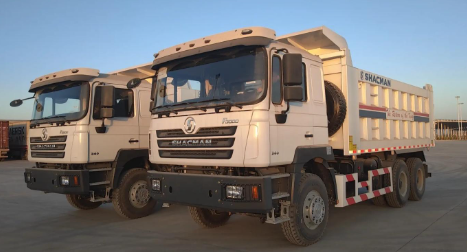The low temperatures, ice and snow, as well as complex road conditions in winter bring numerous challenges to the operation of vehicles. To ensure that your Shacman F3000 dump truck can operate safely and efficiently in winter, please check the following detailed operation guide.
I. Pre-departure Inspection
- Antifreeze: Check whether the antifreeze level is within the normal range. If it is insufficient, add it in time. Meanwhile, check whether the freezing point of the antifreeze meets the requirements of the local lowest winter temperature. If the freezing point is too high, replace it with an appropriate grade of antifreeze to prevent the cooling system from freezing and being damaged.
- Engine Oil: In winter, select engine oil with good low-temperature fluidity and replace or supplement it according to the grade recommended in the vehicle operation manual to ensure that the engine can be quickly and fully lubricated during cold starts.
- Fuel: Choose low-grade diesel fuel suitable for the local temperature, such as -10#, -20# or even lower grades, to avoid waxing of the diesel fuel at low temperatures, which may lead to difficulties in starting the vehicle or stalling during driving.
- Battery: Low temperatures will reduce the performance of the battery. Check the battery power and electrolyte level, and ensure that the electrode connections are firm. If necessary, charge the battery in advance to ensure sufficient power for starting.
- Tires: Check the tire pressure. In winter, the tire pressure can be appropriately increased by 0.2 – 0.3 standard pressure units to compensate for the pressure drop caused by the hardening of the rubber at low temperatures. At the same time, check the tire tread depth. If the tread is severely worn, replace it in time to ensure sufficient grip of the tires on icy and snowy roads.
- Braking System: Check the brake fluid level, ensure that there is no leakage in the brake lines, and check whether the clearance between the brake pads and the brake drum is normal to ensure that the braking system can work normally and reliably in a low-temperature environment.
- Lights: Ensure that all lights, including headlights, fog lights, turn signals, and brake lights, are complete and working properly. In winter, the days are short and the nights are long, and there are many rainy, snow and fog days. Good lighting is an important guarantee for driving safety.
II. Starting and Preheating
- After getting in the vehicle, turn the key to the power-on position first and wait for the dashboard indicator lights to complete self-checking to initialize the vehicle’s electronic system.
- Do not start the engine immediately. For vehicles with manual transmission, step on the clutch pedal first; for vehicles with automatic transmission, check whether the gear is in the parking position, and then press the preheating button to preheat. The preheating time depends on the temperature. Generally, preheat for 1 – 3 minutes when the temperature is low. Start the engine after the preheating indicator light goes off.
- When starting the engine, keep the key in the starting position for 3 – 5 seconds. If the engine fails to start at the first attempt, wait for 15 – 30 seconds before trying again to avoid damaging the starter due to frequent starts. After the engine starts, do not rush to step on the accelerator. Let it idle for 3 – 5 minutes to allow the engine oil to circulate fully and lubricate all engine components.
III. During Driving
- Speed Control: The road adhesion in winter is low, especially on icy and snowy roads. It is essential to strictly control the speed and maintain a safe distance. Generally, the distance should be at least 2 – 3 times that under normal circumstances. Slow down in advance when approaching curves, downhill sections, etc., and avoid sudden braking and sharp turning to prevent the vehicle from skidding and losing control.
- Gear Selection: For vehicles with manual transmission, select the appropriate gear according to the speed and try to keep the engine speed stable. Avoid driving at too low a speed in a high gear, which may lead to stalling due to lugging, and also avoid driving at too high a speed in a low gear to waste fuel; for vehicles with automatic transmission, if there is a snow mode, switch to this mode to allow the vehicle to automatically adjust the shifting logic to adapt to the low-temperature road conditions.
- Use of Snow Chains: On roads with deep snow or severe icing, it is recommended to install snow chains. When installing, ensure that the snow chains are installed firmly and in the correct position. After driving a certain distance, stop and check whether there are any loosening or falling off phenomena.
- Avoid Long Idling: When parking to wait for someone or making a temporary stop, if the waiting time is long, you can appropriately turn off the engine to reduce fuel consumption and exhaust emissions, and also avoid carbon deposition due to long-term idling of the engine.
- Pay Attention to the Instrument Panel: During driving, always pay attention to the indicator lights and parameters such as water temperature, oil pressure, and air pressure on the instrument panel. If there is any abnormality, stop the vehicle in time for inspection to ensure the normal state of the vehicle.
IV. Post-trip Maintenance
- Clean the Vehicle Body: Clean the snow and ice on the vehicle body in time, especially pay attention to the chassis, wheels, brake drums and other parts to prevent the snow from melting and corroding the vehicle body parts or freezing the braking system.
- Replenish Consumables: Check the levels of fuel, engine oil, antifreeze, brake fluid, etc. again and replenish them if there is any consumption.
-
Park the Vehicle: Try to park the vehicle in an indoor parking lot or a place sheltered from the wind and facing the sun. If you can only park it outdoors, you can cover the vehicle with a car cover to reduce wind and snow erosion. At the same time, lift up the windshield wipers to avoid the wiper blades from freezing to the windshield.
By following the above winter operation guide for Shacman F3000 dump trucks, you can easily handle various difficulties in winter driving, ensure the stable performance of the vehicle, extend the service life of the vehicle, and make your transportation journey smoother and safer. Wish you a safe winter driving!
If you are interested, you can directly contact us.
WhatsApp:+8617829390655
WeChat:+8617782538960
Telephone number:+8617782538960
Post time: Dec-24-2024









